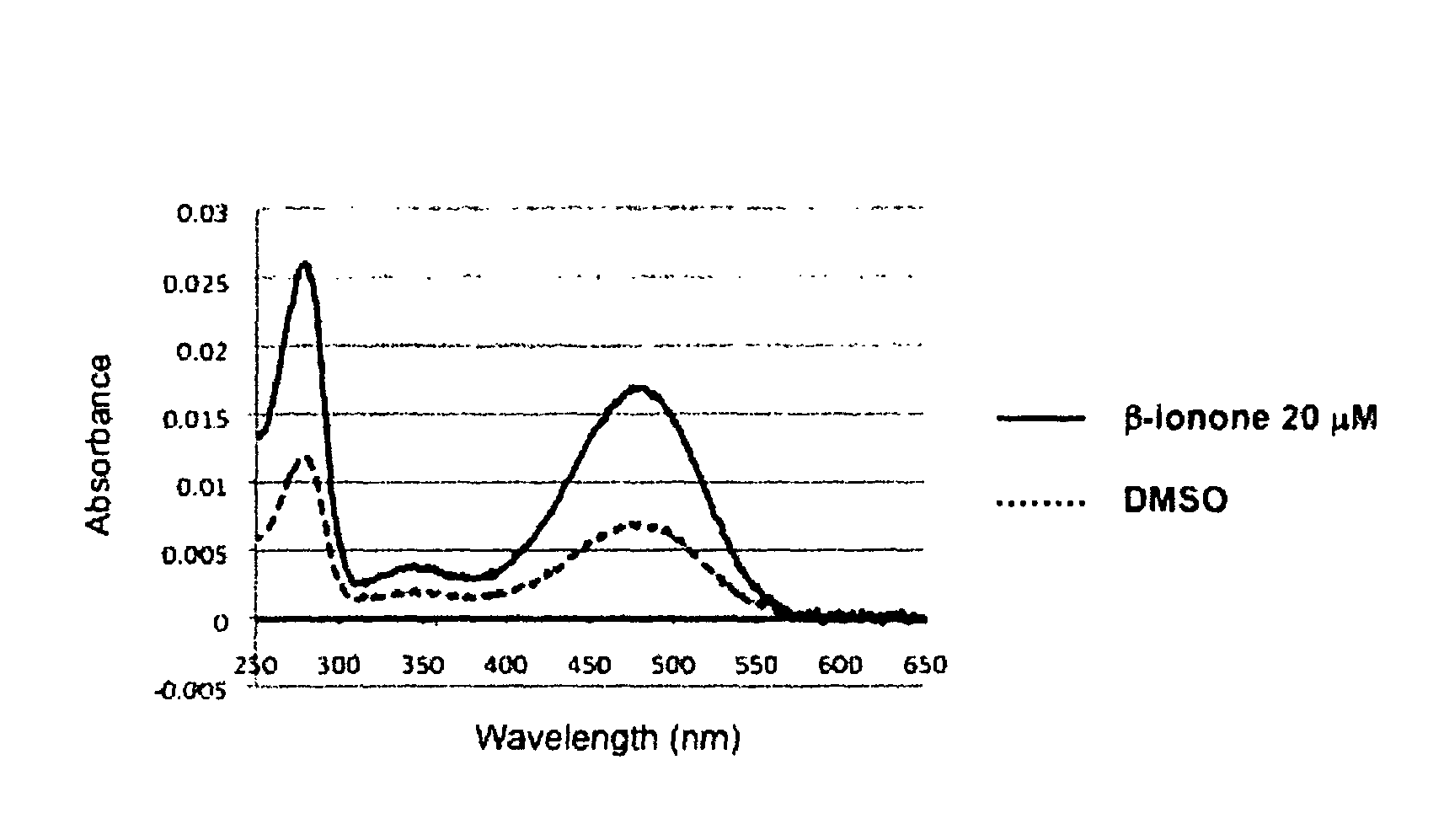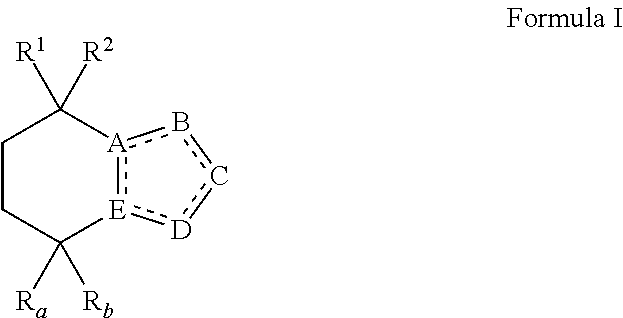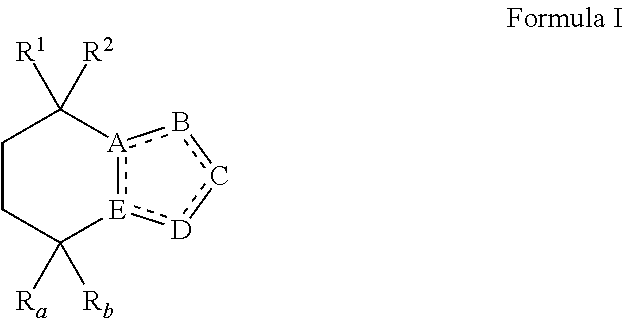Opsin-binding ligands, compositions and methods of use
a technology of opsin and ligands, applied in the field of opsin-binding ligands, compositions and methods of use, can solve the problems of ophthalmic, opsin can exhibit improper folding, and affect the visual perception of the animal so affected, and achieve the effects of reducing the stress on the photoreceptor cell, promoting the appropriate intracellular processing and transport, and reducing the viability of the photoreceptor cell
- Summary
- Abstract
- Description
- Claims
- Application Information
AI Technical Summary
Benefits of technology
Problems solved by technology
Method used
Image
Examples
example 1
(±)-(3aR,7aS)-3,3a,7,7-tetramethyl-3a,4,5,6,7,7a-hexahydro-1H-inden-1-one
[0449]A mixture of (E)-1-(2,6,6-trimethylcyclohex-1-enyl)but-2-en-1-one (400 mg, 2.06 mmol) in phosphoric acid (85%, 3.0 mL) was stirred at room temperature for 3 hours. The mixture was poured into water (30 mL) and the organics extracted with ethyl acetate (40 mL×2). The organic layer was washed with brine, dried over anhydrous sodium sulfate and then concentrated under reduced pressure. The residue was purified by silica gel chromatography to give the title compound as a light yellow oil (362 mg, Yield: 91%). Rf=0.6 (20:1 petroleum ether / ethyl acetate); 1H NMR (400 MHz, CDCl3) δ 5.75 (s, 1H), 1.98 (s, 3H), 1.82 (s, 1H), 1.64-1.52 (m, 4H), 1.36-1.33 (m, 2H), 1.18 (s, 3H), 1.16 (s, 3H), 0.88 (s, 3H) ppm; Mass spectrum (ESI+ve) m / z 193 (M+H+).
Example 2
(±)-(3aS,7aR)-4,4-dimethylhexahydro-1H-indol-2(3H)-one
example 2a
1-benzyl-4,4-dimethyl-3a,4,5,6-tetrahydro-1H-indol-2(3H)-one
[0450]To a solution of ethyl 2-(2,2-dimethyl-6-oxocyclohexyl)acetate (300 mg, 1.413 mmol) in 1,2-dichloroethane (2.5 mL) was added benzylamine (182 mg, 1.7 mmol), acetic acid (170 mg, 2.83 mmol) and sodium triacetoxyborohydride (381 mg, 1.8 mmol). The mixture was stirred at room temperature for 48 hours. The reaction mixture was diluted with dichloromethane (10 mL) and saturated aqueous sodium bicarbonate (5 mL) and the layers were separated. The aqueous layer was extracted with dichloromethane (3×10 mL) and the combined organic phase was dried over anhydrous sodium sulfate and concentrated under reduced pressure. The residue was purified by silica gel column chromatography to afford the title compound as a light yellow oil (88 mg, Yield: 19%). 1H NMR (400 MHz, CDCl3) δ 7.34-7.21 (m, 5H), 4.78 (d, J=15.2 Hz, 1H), 4.75-4.72 (m, 1H), 4.51 (d, J=16.0 Hz, 1H), 2.78-2.61 (m, 1H), 2.52-2.24 (m, 3H), 1.56-1.40 (m, 3H), 1.01 (s, 3H...
example 2b
(±)-(3aS,7aR)-1-benzyl-4,4-dimethylhexahydro-1H-indol-2(3H)-one
[0451]To a solution of the product of Example 2a (88 mg, 0.35 mmol) in methanol (3 mL) was added wet 10% Pd / C (10 mg). The mixture was stirred under an atmosphere of hydrogen overnight and then was suction filtered and the filtrate was concentrated under reduced pressure. The residue was purified by silica gel column chromatography to give the title compound as a colorless oil (46 mg, Yield: 52%). 1H NMR (400 MHz, CDCl3) δ 7.37-7.29 (m, 3H), 7.25 (d, J=7.2 Hz, 2H), 4.94 (d, J=15.6 Hz, 1H), 3.96 (d, J=14.8 Hz, 1H), 3.44-3.32 (m, 1H), 2.38-2.20 (m, 2H), 2.06-1.90 (m, 2H), 1.51-1.48 (m, 1H), 1.32-1.22 (m, 3H), 1.10-0.97 (m, 1H), 0.93 (s, 3H), 0.91 (s, 3H) ppm; Mass spectrum (ESI+ve) m / z 258 (M+H+).
PUM
| Property | Measurement | Unit |
|---|---|---|
| temperatures | aaaaa | aaaaa |
| temperatures | aaaaa | aaaaa |
| temperatures | aaaaa | aaaaa |
Abstract
Description
Claims
Application Information
 Login to View More
Login to View More - R&D
- Intellectual Property
- Life Sciences
- Materials
- Tech Scout
- Unparalleled Data Quality
- Higher Quality Content
- 60% Fewer Hallucinations
Browse by: Latest US Patents, China's latest patents, Technical Efficacy Thesaurus, Application Domain, Technology Topic, Popular Technical Reports.
© 2025 PatSnap. All rights reserved.Legal|Privacy policy|Modern Slavery Act Transparency Statement|Sitemap|About US| Contact US: help@patsnap.com



